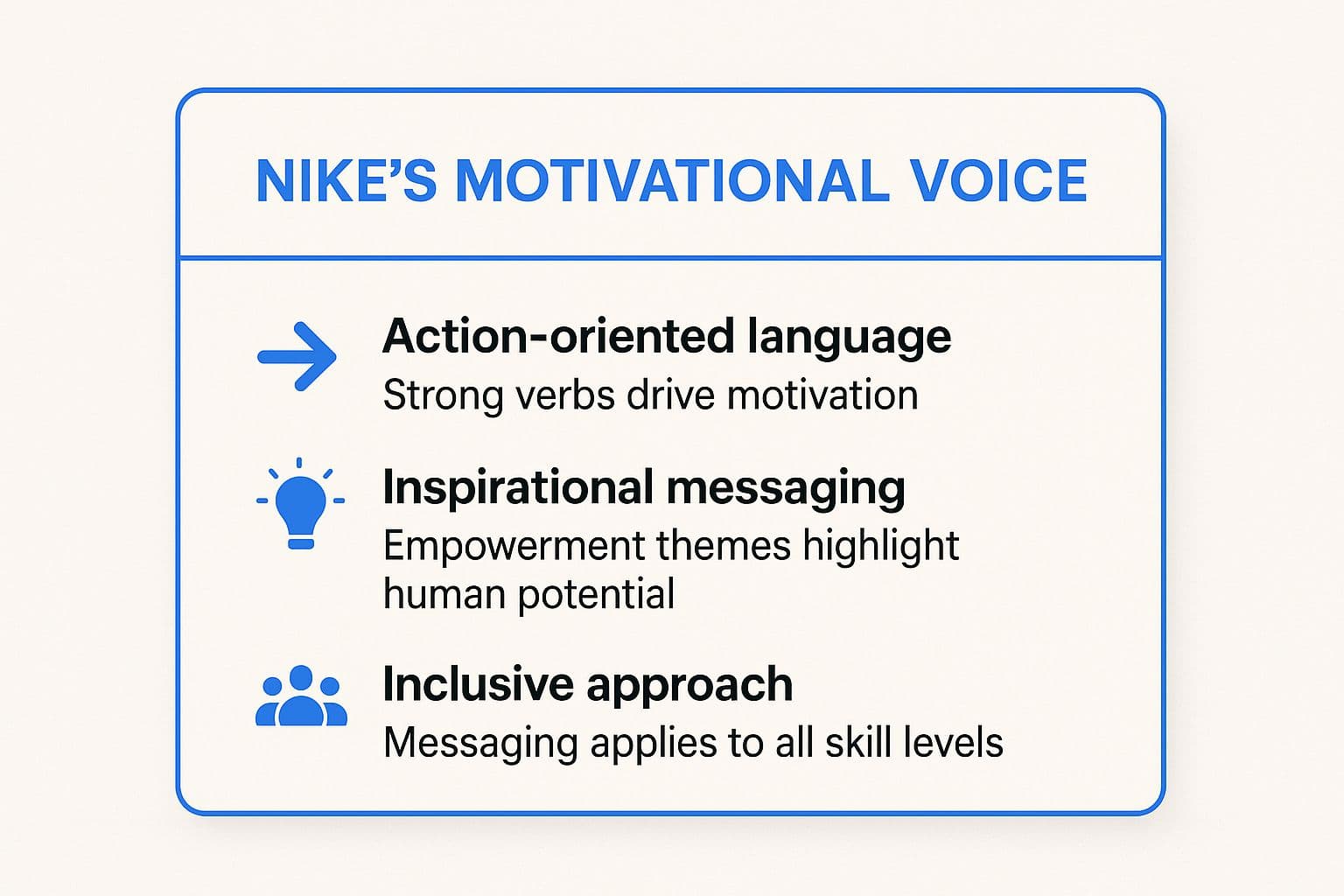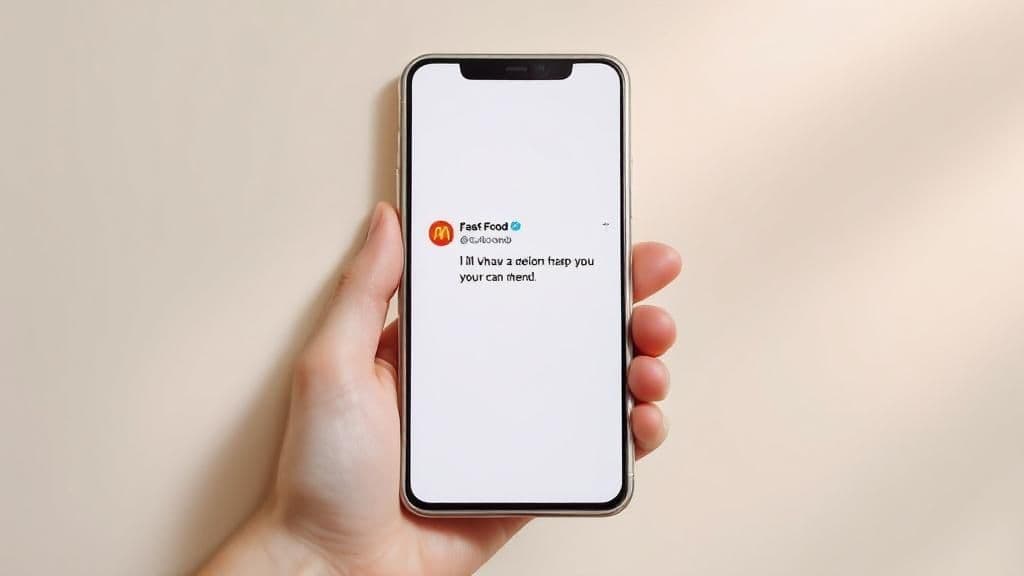7 Incredible Brand Voice Examples to Inspire You in 2025
Discover 7 amazing brand voice examples from top companies like Nike, Apple, and Wendy's. Learn how to create a unique voice that connects with your audience.

Ever read a tweet from a brand and thought, "Wow, I know exactly who that is without even seeing the name?" That's the power of a distinct brand voice. It’s not just what you say, but how you say it. It’s the unique personality and emotion you inject into your communication, making your brand memorable and relatable.
Finding the right voice can feel abstract, but seeing it in action makes it click. This isn’t a theoretical guide; it’s a practical look at some of the best brand voice examples out there. We're going to break down what makes them work, from the specific words they choose to the strategic goals behind their tone. You'll see how companies like Nike inspire action, how Wendy's roasts its way to relevance, and how Patagonia builds a movement with its mission-driven language.
For each example, we'll analyze the strategy and provide actionable takeaways you can apply to your own business, whether you're a solopreneur, a freelance marketer, or a content creator. As you embark on defining your brand voice, remember that it's a crucial component of overall brand consistency. Let's dive into the examples and see how it's done.
1. Nike's Motivational Voice
When you think of a motivational brand, Nike almost always sprints to mind first. For decades, they’ve perfected an empowering and determined brand voice that transcends selling sneakers and apparel. It’s about selling a mindset.
Nike’s voice is confident, energetic, and relentlessly focused on human potential. They speak to the inner athlete in everyone, from the professional to the person just starting their fitness journey. This is one of the most powerful brand voice examples because it connects on a deeply emotional level, inspiring action rather than just purchases.
Strategic Breakdown
The genius of Nike's approach, developed with their long-time agency Wieden+Kennedy, is its simplicity and focus. Their legendary "Just Do It" tagline is the perfect encapsulation of this voice. It’s a direct command, yet it feels like personal encouragement.
This voice is consistently applied everywhere, from high-profile campaigns like "Find Your Greatness" and Colin Kaepernick's "Believe in something," to their everyday social media posts featuring stories of grit and triumph. They focus on the why behind the workout, not just the what.
For a quick reference, this infographic summarizes the core elements of Nike's motivational voice.

As the summary highlights, Nike’s success comes from a powerful combination of action-driven language, inspirational themes, and an inclusive message that makes everyone feel seen.
Actionable Takeaways
How can you channel your inner Nike? It’s about shifting your focus from your product to your customer’s potential.
- Use Strong Verbs: Ditch passive language. Use commanding, active verbs that inspire movement and decisiveness. Think "Conquer," "Achieve," and "Push," not "Our product can help you."
- Tell Stories of Overcoming: Share authentic stories of struggle and success. Whether it's customer testimonials or brand narratives, focus on the journey of overcoming obstacles.
- Empower, Don't Just Sell: Frame your messaging around your customer's achievements. Your product is the tool, but they are the hero.
Adopting this type of voice builds a tribe of loyal followers who see your brand as a partner in their personal growth. For a deeper dive into crafting your own unique messaging, you can explore this comprehensive brand voice guide.
2. Apple's Minimalist and Aspirational Voice
If Nike’s voice is a motivational shout, Apple’s is a confident whisper. Apple has mastered a brand voice that is minimalist, elegant, and deeply aspirational. They don't just sell technology; they sell an intuitive, seamless, and beautifully designed future.

Apple's voice is one of the most distinctive brand voice examples because it strips away complexity. It speaks with quiet authority, using clean and simple language to convey revolutionary ideas. The focus is always on the human experience and creative potential, not on technical jargon or confusing specifications.
Strategic Breakdown
The strategy behind Apple's voice, famously shaped by Steve Jobs and the agency TBWA\Chiat\Day, is to "Think Different." This isn't just a tagline; it's a communications philosophy. Instead of overwhelming customers with specs, they focus on the feeling and the benefit. A camera isn't about megapixels; it’s about capturing memories, as seen in the "Shot on iPhone" campaigns.
This voice is built on a foundation of less is more. Website copy is sparse, product launch keynotes use simple, powerful statements, and even product names like "MacBook Air" evoke a sense of lightness and simplicity. Apple creates desire by presenting its products as keys to a more creative, intuitive, and elevated lifestyle. They lead with design and innovation, making the technology feel almost magical.
Actionable Takeaways
How can you adopt Apple’s sophisticated simplicity? It starts by focusing on clarity and the end-user benefit.
- Focus on Benefits, Not Features: Instead of saying "12-megapixel sensor," say "Capture stunningly detailed photos." Translate technical specs into tangible human outcomes.
- Use Simple, Direct Language: Cut the jargon and corporate speak. Write in a way that is easy to understand, using short sentences and common words to explain powerful concepts.
- Embrace White Space: Your communication's design is part of its voice. Whether on a webpage or in an email, give your words room to breathe. This creates a feeling of calm, focus, and premium quality.
- Lead with Aspiration: Position your product or service as a tool that helps users become a better version of themselves. Your brand is the enabler, and the customer is the creative genius.
Adopting this voice helps establish a premium, expert position. It tells your audience that you are so confident in your product's value that you don't need to shout about it.
3. Wendy's Sassy and Humorous Voice
When it comes to unforgettable brand voice examples, Wendy's has roasted the competition to become the undisputed queen of sass. Instead of traditional corporate communication, Wendy's broke the mold with a voice that is witty, self-aware, and hilariously sarcastic, especially on platforms like X (formerly Twitter). This approach transformed a fast-food chain into a must-follow internet personality.

Wendy’s voice is sharp, playful, and deeply fluent in internet culture. They engage directly with fans and competitors, using pop culture references, memes, and friendly roasts to create viral moments. This strategy, masterfully executed with their agency partners at VML, makes the brand feel more like a friend you’d banter with than a faceless corporation.
Strategic Breakdown
The secret to Wendy’s success is its commitment to being authentically entertaining. The brand doesn't just use humor; it embodies it. Their social media team is empowered to be quick, clever, and consistently on-brand, turning simple customer interactions into shareable content.
This voice is most famous for its Twitter roasts, but its influence extends to major campaigns. The "Nuggs for Carter" phenomenon, which became one of the most retweeted posts of all time, started from a simple, playful interaction with a fan. Wendy's recognized the opportunity and leaned into the moment, demonstrating a perfect balance of humor and community engagement. They don't just talk at their audience; they talk with them.
Actionable Takeaways
Want to add a little Wendy's-style spice to your brand voice? It's about knowing your audience and not being afraid to show some personality.
- Define Your Comic Persona: Are you sarcastic, witty, goofy, or charmingly awkward? Choose a specific type of humor and stick with it. Consistency is what makes the voice believable.
- Engage in Real-Time Banter: Monitor social media conversations and be ready to jump in. Engage with followers, other brands, and trending topics with a timely, clever comment. The goal is to be part of the conversation, not just to broadcast messages.
- Balance Wit with Value: Humor is the hook, but you still need to deliver value. Ensure your playful content is balanced with posts about your product's benefits, customer service, and brand values. Don’t let the jokes completely overshadow your core business.
Adopting a humorous voice can make your brand incredibly memorable and relatable, turning passive followers into active, loyal fans. For those looking to build a brand that truly connects, check out the Wendy's X account for a masterclass in action.
4. Patagonia's Activist and Authentic Voice
Patagonia has built an identity that’s as much about activism as it is about outdoor gear. Their voice is not just a marketing tactic; it's a direct reflection of their core mission to save our home planet. This creates a deeply authentic and purpose-driven communication style that resonates with a community of conscious consumers.
Patagonia’s voice is rugged, honest, and unflinchingly direct. They speak about environmental issues with the same passion and expertise they use to describe a new hardshell jacket. This is one of the most compelling brand voice examples because it proves that a brand can stand for something bigger than its products and build immense loyalty by doing so.
Strategic Breakdown
Founded by rock climber and environmentalist Yvon Chouinard, Patagonia's activist voice is baked into its DNA. Their most famous campaign, "Don't Buy This Jacket," is a masterclass in this approach. It challenged consumerism head-on during Black Friday, cementing their reputation for prioritizing the planet over profit.
This voice is consistently applied across all their communications. From their Worn Wear program, which celebrates repair over replacement, to their vocal political stances and funding of environmental grants, their words are always backed by action. They don't just sell you gear; they educate you on responsible ownership and invite you to join their cause.
Actionable Takeaways
How can you build a voice with authentic purpose? It starts with aligning your words with genuine, demonstrable company values.
- Lead with Your Mission: Place your core mission at the forefront of your messaging. Talk about why your company exists beyond making money. This creates a stronger emotional connection.
- Educate, Don't Just Pitch: Use your platform to inform your audience about issues that matter to your brand. Frame your content around education and shared values rather than just product features.
- Be Prepared to Take a Stand: A purpose-driven voice sometimes means taking a stance on controversial topics. While it can be risky, it also builds a fiercely loyal community that shares your convictions.
- Prove It with Action: The most crucial element is authenticity. Your actions must consistently support your words. Share stories of your company’s efforts, whether it's through sustainable practices, community involvement, or ethical choices.
Adopting this type of voice turns customers into advocates who are invested in your mission, not just your products. For more on their philosophy, exploring the Worn Wear program provides a perfect case study.
5. Mailchimp's Friendly and Approachable Voice
In a world filled with complex tech jargon, Mailchimp stands out by making sophisticated marketing tools feel simple and even fun. Their brand voice is intentionally friendly, approachable, and consistently helpful, turning what could be a daunting task into an empowering experience for small businesses.
Mailchimp’s voice is warm, conversational, and full of empathy. They talk to entrepreneurs and creators like a supportive colleague, not a faceless corporation. This is one of the most effective brand voice examples for any B2B company because it demystifies a complex service and builds genuine trust with users who might otherwise feel overwhelmed.
Strategic Breakdown
The brilliance of Mailchimp’s voice, shaped by co-founders Ben Chestnut and Dan Kurzius, is its commitment to clarity and encouragement. They traded corporate-speak for plain language and sprinkled in delightful moments of humor, like their famous high-fiving chimp, Freddie, who celebrated with you after sending a campaign.
This voice is woven through every touchpoint, from their easy-to-follow onboarding emails and tutorials to their genuinely helpful support interactions. Even their error messages are designed to be reassuring rather than alarming. They anticipate user anxiety and proactively address it with a calm, friendly tone, making users feel capable and supported.
Their success proves that a professional brand doesn't have to be stuffy. By prioritizing a human-centric, conversational style, they've built a fiercely loyal user base that feels seen and understood.
Actionable Takeaways
How can you adopt a Mailchimp-style friendly voice? It's about putting yourself in your customer's shoes and speaking their language.
- Use Conversational Language: Write like you talk. Use contractions, ask questions, and ditch the formal jargon. Instead of "Utilize our platform to," try "You can use our tool to."
- Show Empathy: Acknowledge your customer's pain points. Phrases like "We know it can be tricky to..." or "Getting started is sometimes the hardest part" show you understand their challenges.
- Inject Appropriate Humor: A well-placed bit of lightheartedness or a fun illustration can diffuse tension and make your brand more memorable. Keep it brand-aligned and never at the customer's expense.
Balancing this friendly tone with a clear, professional message is key. For those looking to master this blend in their own work, you can explore how to write professionally without sounding robotic.
6. Old Spice's Bold and Masculine Voice
Old Spice engineered one of the most dramatic brand voice turnarounds in modern history. They transformed from a brand associated with your grandfather's aftershave into a viral sensation by embracing an over-the-top, confident, and wildly humorous personality. Their voice is pure, unapologetic hyperbole.
The brand's voice is built on absurdly masculine claims and self-aware comedy. It speaks directly to its audience, often breaking the fourth wall with a knowing wink. This is one of the most effective brand voice examples because it revitalized an aging brand, making it relevant and highly entertaining for a new generation while also appealing to the women who often purchase men's products.
Strategic Breakdown
The pivot, masterminded with Wieden+Kennedy, was a high-risk, high-reward move that paid off spectacularly. The "The Man Your Man Could Smell Like" campaign, featuring a smooth-talking Isaiah Mustafa, set the stage. The voice is not just masculine; it's a parody of masculinity, delivered with such deadpan confidence that it becomes irresistibly funny.
This voice is consistently applied across all marketing, from the original iconic commercials to Terry Crews' explosive, high-energy ads and their interactive social media responses. They don't just sell deodorant; they sell an impossible, hilarious fantasy. The content is designed to be shared, turning viewers into brand evangelists.
Actionable Takeaways
How do you inject some Old Spice-level confidence into your brand? It’s about being bold enough to not take yourself too seriously.
- Embrace Exaggeration: Take a core product benefit and amplify it to a ridiculous degree. What’s the most outrageous claim you could make? Use that as your creative starting point.
- Use Humor to Make Bold Claims: A confident, tongue-in-cheek tone allows you to make statements that would otherwise sound arrogant. Laughter makes bold claims more memorable and less salesy.
- Create a Distinct Character: Personify your brand. Is it a charming gentleman on a horse? A muscle-bound powerhouse who screams? Giving your voice a character makes it consistent and recognizable.
7. Innocent Drinks' Playful and Quirky Voice
In a world full of serious health claims, Innocent Drinks brings a refreshing dose of playfulness. The brand has mastered a quirky, conversational, and genuinely charming brand voice that makes healthy choices feel less like a chore and more like a joy. It’s all about simple, friendly fun.
Innocent’s voice is characterized by its childlike simplicity, clever puns, and disarming honesty. They talk to their customers like friendly acquaintances, sharing little jokes and random thoughts on their packaging and social media. This is one of the most effective brand voice examples for humanizing a product, making the company feel approachable, transparent, and instantly likable.
Strategic Breakdown
The strategy behind Innocent's voice, established by founders Richard Reed, Adam Balon, and Jon Wright, is to cut through the corporate noise. Their voice is built on a foundation of being, well, innocent. It’s a direct rejection of jargon and hard-sell tactics, opting instead for a chatty and endearingly simple tone.
This voice is consistently woven into every single touchpoint. The bottom of their smoothie bottles might have a silly message like "Stop looking at my bottom." Their social media is a stream of witty observations and fruit-related puns, and even their formal "hello@innocentdrinks.co.uk" email is known as "the banana phone." They create a consistent world of delightful, low-stakes humor.
This approach makes customers feel like they are part of an inside joke, building a strong community around shared values of simplicity and fun.
Actionable Takeaways
How can you inject some of Innocent's charm into your own brand? It’s about finding the fun in what you do and sharing it simply.
- Write Like You Talk: Drop the corporate-speak. Use simple words, short sentences, and a conversational flow. Imagine explaining your product to a friend.
- Find Joy in the Details: Look for opportunities to add small, delightful surprises. This could be a funny sign-off in an email, a quirky instruction on your product, or a random fact in a social media post.
- Be Endearingly Honest: Don’t be afraid to be a little self-deprecating or admit when things aren’t perfect. This vulnerability builds trust and makes your brand more relatable.
Embracing this voice can transform your brand from a faceless entity into a beloved personality. To help maintain this unique tone consistently across all your writing, you might want to explore how an AI writing assistant can help.
Brand Voice Style Comparison of 7 Leading Brands
| Brand Voice | Implementation Complexity 🔄 | Resource Requirements ⚡ | Expected Outcomes 📊 | Ideal Use Cases 💡 | Key Advantages ⭐ |
|---|---|---|---|---|---|
| Nike's Motivational Voice | Medium - requires consistent action-oriented tone and authentic storytelling | Moderate - steady content creation across channels | High emotional impact, strong brand loyalty, motivation to act | Brands aiming to inspire and empower broad audiences | Builds emotional connection, motivates action, inclusive |
| Apple's Minimalist and Aspirational Voice | High - demands simplicity with premium messaging backed by product excellence | High - design and innovation-focused resources | Creates premium perception, anticipation for launches | Premium tech/design brands focusing on user experience | Premium brand image, easy recall, differentiation through elegance |
| Wendy's Sassy and Humorous Voice | Medium - requires quick, witty, and well-managed social media engagement | Moderate - skilled social media team needed | High social media engagement, viral potential | Brands seeking playful, youthful, and viral social media presence | Memorable, viral content, strong engagement |
| Patagonia's Activist and Authentic Voice | High - requires genuine activism and consistent value-driven messaging | High - commitment to activism, storytelling | Strong loyalty, emotional investment, attracts conscious consumers | Mission-driven, purpose-oriented brands | Authenticity, strong brand loyalty, emotional connection |
| Mailchimp's Friendly and Approachable Voice | Low to Medium - conversational and empathetic tone with balanced professionalism | Moderate - ongoing customer support and friendly content | Builds trust, reduces intimidation, encourages engagement | Small business support, user-friendly services | Accessibility, trust building, approachable for novices |
| Old Spice's Bold and Masculine Voice | Medium - requires creative, exaggerated humor with consistent delivery | Moderate - creative and advertising focused | Highly memorable, revitalizes brand, creates viral moments | Brands targeting humor-savvy, broad audiences | Shareable, memorable, revitalizes brand image |
| Innocent Drinks' Playful and Quirky Voice | Medium - creative, pun-filled tone that requires consistency | Moderate - creative writing and marketing support | Strong emotional attachment, memorable, broad appeal | Brands wanting fun, approachable, and distinctive communication | Distinctive, emotionally engaging, broad demographic appeal |
Final Thoughts
We've just journeyed through a powerful lineup of brand voice examples, from Nike's awe-inspiring motivation to Wendy's hilarious jabs on social media. Each one offers a masterclass in how a distinct personality can transform a simple product or service into an unforgettable experience.
But here’s the biggest takeaway: none of these voices were born overnight. They are the result of deliberate choices, deep audience understanding, and relentless consistency. Apple’s aspirational minimalism and Patagonia’s rugged activism feel authentic because every tweet, product description, and ad campaign reinforces the same core identity.
Your Blueprint for a Memorable Voice
So, where do you go from here? Staring at a blank page and trying to invent a personality can feel intimidating. Instead, let’s boil down the lessons from these iconic brands into actionable steps you can take right now.
- Define Your Core Personality: Before you write a single word, ask yourself: If my brand were a person, who would it be? The wise mentor (like Nike)? The witty friend (like Innocent Drinks)? The minimalist innovator (like Apple)? Write down 3-5 core personality traits.
- Map Your Voice to Your Audience: A great brand voice doesn’t just talk, it listens. It reflects the language, values, and aspirations of its target audience. Patagonia speaks to activists and outdoor enthusiasts because that’s who buys their gear. Your voice must resonate with the people you want to serve.
- Create a Simple Style Guide: You don't need a 50-page document. Start with a one-pager that answers these questions:
- What specific words do we use? (e.g., "collaborate" instead of "synergize")
- What words do we avoid? (e.g., "cheap" instead of "affordable")
- What is our go-to tone? (e.g., "empowering and direct," "playful and quirky")
- How do we use humor? (e.g., "self-deprecating but never sarcastic")
Consistency is Your Superpower
Ultimately, the magic of a strong brand voice lies in its consistency. It’s what builds trust and makes your audience feel like they truly know you. Every email, social media post, and support ticket is an opportunity to reinforce who you are. The most successful brand voice examples we've looked at prove that when you show up as the same authentic brand everywhere, you earn more than just customers; you build a loyal community.
Your voice is your most powerful, non-visual asset. It's the thread that connects your mission to your audience, turning passive browsers into passionate advocates. Don’t just sell a product or service. Use your unique voice to tell a story, build a relationship, and create a brand that people are genuinely excited to be a part of.
Ready to find your voice and apply it consistently across every platform? TypeBoost is your AI writing partner that learns your unique style, helping you draft emails, social posts, and documents that sound perfectly like you, every single time. Stop switching between apps and start writing with confidence by trying TypeBoost today.